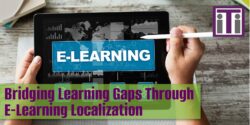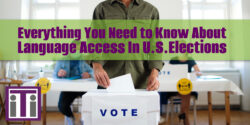
In recent years, education and corporate training have moved from in-person to online settings. In recent years, education and corporate training have shifted from in-person to online settings. This change is driven by the desire for education to be accessible to learners from various locations, time zones, and languages.
Bridging Learning Gaps Through E-Learning Localization
E-learning translation is becoming more important, particularly in the corporate world where inclusivity and accessibility are key priorities.
As companies expand globally, there is a growing need for e-learning programs that can accommodate employees from different language backgrounds.
But how do you ensure that a safety policy course designed at a U.S. headquarters resonates equally with employees in Europe, Asia, or any other corner of the globe?
The answer lies in e-learning localization, a process that transcends mere translation, considering the nuances of local cultures, and ensuring that every employee, regardless of their first language, receives the same level of training and information.
The Crux of E-Learning Translation
E-Learning localization is not about reinventing the wheel, it’s about adapting the content thoughtfully and efficiently to new audiences. It’s about making learning inclusive and accessible, ensuring that there are no language barriers to critical information.
A partnership with a reputable language services company can transform the daunting task of training materials translation and localization into a manageable, streamlined process. Here’s a closer look at what this involves:
Critical Considerations in Localizing E-Learning Courses
E-learning localization involves both the translation and localization of text, and creating video translations through subtitles and/or voiceovers.
- Subtitles and On-Screen Text: Subtitles are a vital tool for expanding your video library. In addition to being accurate, text expands or contracts when translated into different languages. This requires the adjustment of the on-screen layout accordingly.
- Selecting the correct narrator is crucial to maintain the essence of the original content. It also helps in meeting the language and cultural expectations of the new audience. The right narrator can enhance the overall experience for the audience. It is important to consider the narrator’s voice, tone, and style when making this decision. The content’s tone, pace, and emotion must transition seamlessly across languages.
- When translating content with on-screen speakers, it’s important to make sure the words match the lip movements. This ensures a seamless and natural flow in the localized version, keeping viewers interested. This helps to maintain a smooth and natural flow in the localized version, keeping viewers engaged with the content.
- Cultural Adaptation: It’s also vital to adapt content to align with the local culture’s norms and values, avoiding potential misunderstandings or cultural insensitivities.
E-learning localization can look like a difficult task. However, with a structured approach, the right expertise, and attention to detail, it’s perfectly achievable and brings a tangible return on investment.
E-Learning Localization: A Step Towards Global Connectivity
 Once localized, these e-learning modules become bridges connecting global teams, ensuring every individual, regardless of location or language, has the resources to grow, learn, and contribute effectively. The final step involves integrating the translated modules back onto your platforms, ready to enrich your global team.
Once localized, these e-learning modules become bridges connecting global teams, ensuring every individual, regardless of location or language, has the resources to grow, learn, and contribute effectively. The final step involves integrating the translated modules back onto your platforms, ready to enrich your global team.
Digital technology is being used more in education. Adapting e-learning for different languages and regions is important for breaking down barriers. Universities, HR professionals, corporate trainers, and educators can now reach a global audience through e-learning translation and localization. Universities, HR professionals, corporate trainers, and educators can now reach a global audience through e-learning translation and localization.
Advancements in Technology for E-Learning Translation
As technology continues to evolve at breakneck speed, so does its impact on the field of e-learning translation. With advancements in artificial intelligence and machine learning, there are now tools available that can assist with aspects of the e-learning localization process, such as automatic speech recognition and machine translation.
These technologies can help streamline the process, reduce costs, and improve overall efficiency. However, they should be used with caution and in conjunction with human translators to ensure accuracy and preserve linguistic nuances. See more on this topic in our article Will AI Replace Human Translators?
As technology progresses, it will become increasingly important for language service providers to stay updated and embrace new tools and techniques that can enhance their e-learning localization services. This will not only benefit clients but also contribute towards the growth and evolution of the industry as a whole.
Conclusion
E-learning translation and localization are rapidly growing industries with immense potential to bridge linguistic barriers, unite global teams, and improve accessibility and inclusivity in education and training. By understanding the critical considerations involved in localizing e-learning courses and embracing advancements in technology, organizations can ensure that their training materials reach a wider audience and drive success on a global scale. So let’s continue to embrace the power of e-learning localization and build a more connected world through education. #
Connect with Us
Interested in learning more about e-learning translation and localization? Reach out to us at 860-968-6777, follow us on social media for updates, tips, and insights into the industry, or tell us about your language services needs using the link below. Let’s work together to break down language barriers and connect the world through education.
| Talk to an Expert |
Interpreters and Translators, Inc. is a full-service language solutions company based in Glastonbury, Connecticut. iTi is an NMSDC-certified minority owned business.





